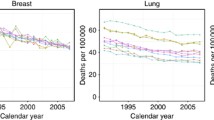Abstract
Purpose
The paper presents the statistical analysis of current and past trends of cancer mortality rates in Germany in terms of annual percent change, overall and for the major sites, and contrasts them with trends in incidence of the Cancer Registry of the Saarland, the only registry in this country with long-term completeness. It addresses also the issue of a cross-over of cancer mortality and mortality from cardiovascular diseases (CVD) in the near future, as suggested by various authors.
Material and methods
Analyses are based on the mortality data of the official mortality statistics as published by the Federal Statistical Office and reported annually to the WHO, and the regularly reported incidence data of the Cancer Registry of the Saarland. The data was age-standardised and analysed by piecewise regression using a freely available dedicated software package.
Results
The report shows a downward trend of mortality rates for all cancers combined based on declining rates for many individual sites with only few exceptions affecting mainly females (e.g. lung cancer). Recently, the long-term increase of cancer incidence also flattened out with rather heterogeneous underlying site-specific trends increasing for some sites (e.g. cancers of the intestine, breast, prostate, or some lymphoma) and decreasing for others (e.g. cancers of the stomach, gall bladder in females, larynx, and lung in males). A crossover of cancer mortality and mortality from CVD might occur—if at all—after 2,020 in males and 2,030 in females.
Conclusions
Depending on cancer site, primary prevention (e.g. lung cancer among males), early detection (cervical cancer), and treatment (e.g. breast and testicular cancer, lymphoma) contributed to the current decline of mortality rates. Absence of a turnaround (e.g. lung cancer among females), slower decline than in other countries (e.g. cervical cancer), or later turnaround (e.g. breast cancer) may be related to failures in promoting prevention (lung cancer among females), early detection programmes (cervical cancer), or delays in the translation of modern treatment into routine health care (breast cancer) and indicate major challenges for current and future health policy.



Similar content being viewed by others
References
Auvinen A, Alexander FE, De Koning HJ, Miller AB (2002) Should we start population screening for prostate cancer? Randomised trials are still needed. Int J Cancer 97:377–378
Baade PD, Coory MD, Aitken JF (2004) International trends in prostate-cancer mortality: the decrease is continuing and spreading. CCC 15:237–241
Becker N (2001) Development of incidence and mortality in breast cancer (in German). Der Radiologe 41:337–343
Becker N (2003) Epidemiological aspects of cancer screening in Germany. J Cancer Res Clin Oncol 129:691–702
Becker N (2004) PSA-test for early detection of prostate cancer (in German). Der Onkologe 10:66–74
Becker N, Boyle P (1997) Decline in mortality from testicular cancer in West Germany after reunification. Lancet 350:744
Becker N, Wahrendorf J (1997) Atlas of cancer mortality in Germany 1981–1990, third edn. Springer, Berlin Heidelberg New York
Berry DA, Cronin KA, Plevritis SK, Fryback DG, Clarke L, Zelen M, Mandelblatt JS, Yakovlev AY, Habbema JDF, Feuer EJ (2005) Effect of screening and adjuvant therapy on mortality from breast cancer. N Engl J Med 353:1784–1792
Boyle P (2003) Testicular cancer: the challenge for cancer control. Lancet Oncol 5:56–61
Bray F, Loos AH, Tognazzo S, La Vecchia C (2005) Ovarian cancer in Europe: cross-sectional trends in incidence and mortality in 28 countries, 1953–2000. Int J Cancer 113:977–990
Brenner H, Stegmaier C, Ziegler H (2005) Long-term survival of cancer patients in Germany achieved by the beginning of the third millenium. Ann Oncol 16:981–986
Chamberlain J, Melia J, Moss S, Brown J (1997) Report prepared for the health thechnology assessment panel of the NHS executive on the diagnosis, management, treatment and costs of prostate cancer in England and Wales. Br J Urol 79 (Suppl. 3):1–32
Der Spiegel (1998) Successes in the phantom world (in German). Der Spieg 6:186–187
Diehl V, Thomas RK, Re D (2004) Hodgkin’s lymphoma: diagnosis and treatment. Lancet Oncol 5:19–26
Gatta G, Capocaccia R, Stiller C, Kaatsch P, Berrino F, Terenziani M, the EUROCARE Working Group (2005) Childhood cancer survival trends in Euorpe: a EUROCARE Working Group study. J Clin Oncol 23:3742–3751
Heuer C, Becker N (1999) Smoking prevalence and lung cancer mortality in Germany. J Epidem Biostat 4:45–52
Höpker WW (1998) Flickenteppich mit falschen Farben. Dtsch Ärzteblatt 95 (34/35):A-2017–A-2019
Howson CP, Hiyama T, Wynder EL (1986) The decline in gastric cancer: epidemiology of an unplanned triumph. Epidemiol Rev 8:1–27
IARC (2002) Breast cancer screening. IARC Handbooks of cancer prevention, vol 7. International agency for research on cancer. World Health Organization. IARC Press, Lyon
Katalinic A (2004) Epidemiologische Krebsregistrierung in Deutschland—Bestandsaufnahme und Perspektiven. Bundesgesundheitsblatt 47:422–428
Kim H-J, Fay MP, Feuer EJ, Midthune DN (2000) Permutation tests for joinpoint regression with application to cancer rates. Stat Med 19:335–351
Nyrén O, Adami H-O (2002) Stomach cancer. In: Adami H-O, Hunter D, Trichopoulos D (eds) Textbook of cancer epidemiology. Oxford University Press, Oxford, New York, pp 162–187
Oliver SE, May MT, Gunnell D (2001) International trends in prostate-cancer mortality in the PSA-era. Int J Cancer 92:892–898
Ries LA, Wingo PA, Miller DS, Howe HL, Weir HK, Rosenberg HM, Vernon SW, Cronin K, Edwards BK (2000) The annual report to the nation on the status of cancer, 1973–1997, with a special section on colorectal cancer. Cancer 88:2398–2424
Schrader M, Weißbach L, Miller K (2004) Treatment of testicular cancer (in German). Dtsch Ärzteblatt 101(39):A 2612–A 2618
Author information
Authors and Affiliations
Corresponding author
Rights and permissions
About this article
Cite this article
Becker, N., Altenburg, HP., Stegmaier, C. et al. Report on trends of incidence (1970–2002) of and mortality (1952–2002) from cancer in Germany. J Cancer Res Clin Oncol 133, 23–35 (2007). https://doi.org/10.1007/s00432-006-0142-4
Received:
Accepted:
Published:
Issue Date:
DOI: https://doi.org/10.1007/s00432-006-0142-4




